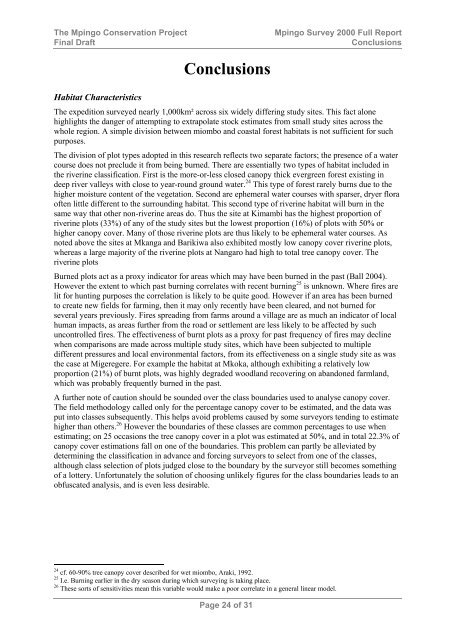the Mpingo Conservation Project - Coastal Forests of Kenya and ...
the Mpingo Conservation Project - Coastal Forests of Kenya and ...
the Mpingo Conservation Project - Coastal Forests of Kenya and ...
You also want an ePaper? Increase the reach of your titles
YUMPU automatically turns print PDFs into web optimized ePapers that Google loves.
The <strong>Mpingo</strong> <strong>Conservation</strong> <strong>Project</strong><br />
Final Draft<br />
<strong>Mpingo</strong> Survey 2000 Full Report<br />
Conclusions<br />
Habitat Characteristics<br />
Conclusions<br />
The expedition surveyed nearly 1,000km² across six widely differing study sites. This fact alone<br />
highlights <strong>the</strong> danger <strong>of</strong> attempting to extrapolate stock estimates from small study sites across <strong>the</strong><br />
whole region. A simple division between miombo <strong>and</strong> coastal forest habitats is not sufficient for such<br />
purposes.<br />
The division <strong>of</strong> plot types adopted in this research reflects two separate factors; <strong>the</strong> presence <strong>of</strong> a water<br />
course does not preclude it from being burned. There are essentially two types <strong>of</strong> habitat included in<br />
<strong>the</strong> riverine classification. First is <strong>the</strong> more-or-less closed canopy thick evergreen forest existing in<br />
deep river valleys with close to year-round ground water. 24 This type <strong>of</strong> forest rarely burns due to <strong>the</strong><br />
higher moisture content <strong>of</strong> <strong>the</strong> vegetation. Second are ephemeral water courses with sparser, dryer flora<br />
<strong>of</strong>ten little different to <strong>the</strong> surrounding habitat. This second type <strong>of</strong> riverine habitat will burn in <strong>the</strong><br />
same way that o<strong>the</strong>r non-riverine areas do. Thus <strong>the</strong> site at Kimambi has <strong>the</strong> highest proportion <strong>of</strong><br />
riverine plots (33%) <strong>of</strong> any <strong>of</strong> <strong>the</strong> study sites but <strong>the</strong> lowest proportion (16%) <strong>of</strong> plots with 50% or<br />
higher canopy cover. Many <strong>of</strong> those riverine plots are thus likely to be ephemeral water courses. As<br />
noted above <strong>the</strong> sites at Mkanga <strong>and</strong> Barikiwa also exhibited mostly low canopy cover riverine plots,<br />
whereas a large majority <strong>of</strong> <strong>the</strong> riverine plots at Nangaro had high to total tree canopy cover. The<br />
riverine plots<br />
Burned plots act as a proxy indicator for areas which may have been burned in <strong>the</strong> past (Ball 2004).<br />
However <strong>the</strong> extent to which past burning correlates with recent burning 25 is unknown. Where fires are<br />
lit for hunting purposes <strong>the</strong> correlation is likely to be quite good. However if an area has been burned<br />
to create new fields for farming, <strong>the</strong>n it may only recently have been cleared, <strong>and</strong> not burned for<br />
several years previously. Fires spreading from farms around a village are as much an indicator <strong>of</strong> local<br />
human impacts, as areas fur<strong>the</strong>r from <strong>the</strong> road or settlement are less likely to be affected by such<br />
uncontrolled fires. The effectiveness <strong>of</strong> burnt plots as a proxy for past frequency <strong>of</strong> fires may decline<br />
when comparisons are made across multiple study sites, which have been subjected to multiple<br />
different pressures <strong>and</strong> local environmental factors, from its effectiveness on a single study site as was<br />
<strong>the</strong> case at Migeregere. For example <strong>the</strong> habitat at Mkoka, although exhibiting a relatively low<br />
proportion (21%) <strong>of</strong> burnt plots, was highly degraded woodl<strong>and</strong> recovering on ab<strong>and</strong>oned farml<strong>and</strong>,<br />
which was probably frequently burned in <strong>the</strong> past.<br />
A fur<strong>the</strong>r note <strong>of</strong> caution should be sounded over <strong>the</strong> class boundaries used to analyse canopy cover.<br />
The field methodology called only for <strong>the</strong> percentage canopy cover to be estimated, <strong>and</strong> <strong>the</strong> data was<br />
put into classes subsequently. This helps avoid problems caused by some surveyors tending to estimate<br />
higher than o<strong>the</strong>rs. 26 However <strong>the</strong> boundaries <strong>of</strong> <strong>the</strong>se classes are common percentages to use when<br />
estimating; on 25 occasions <strong>the</strong> tree canopy cover in a plot was estimated at 50%, <strong>and</strong> in total 22.3% <strong>of</strong><br />
canopy cover estimations fall on one <strong>of</strong> <strong>the</strong> boundaries. This problem can partly be alleviated by<br />
determining <strong>the</strong> classification in advance <strong>and</strong> forcing surveyors to select from one <strong>of</strong> <strong>the</strong> classes,<br />
although class selection <strong>of</strong> plots judged close to <strong>the</strong> boundary by <strong>the</strong> surveyor still becomes something<br />
<strong>of</strong> a lottery. Unfortunately <strong>the</strong> solution <strong>of</strong> choosing unlikely figures for <strong>the</strong> class boundaries leads to an<br />
obfuscated analysis, <strong>and</strong> is even less desirable.<br />
24 cf. 60-90% tree canopy cover described for wet miombo, Araki, 1992.<br />
25 I.e. Burning earlier in <strong>the</strong> dry season during which surveying is taking place.<br />
26 These sorts <strong>of</strong> sensitivities mean this variable would make a poor correlate in a general linear model.<br />
Page 24 <strong>of</strong> 31
















